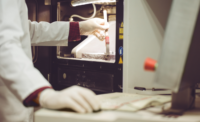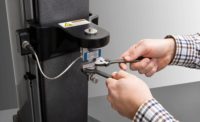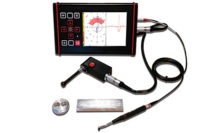Simulation can be an invaluable tool in designing probes and inspection strategies for optimal performance. Typical drivers in designing an inspection are speed, accuracy and cost. Although all three are almost always part of the evaluation criteria when developing an inspection procedure, the relative importance of the three varies depending on the application. For example, during manufacturing, speed is often paramount, especially for fully automated industrial production and relatively low-value processes. For high-value processes and safety-critical components, high resolution is mandated to allow accurate detection and sizing of anomalies. In almost all cases, the over-riding objective is to evaluate candidate inspection options to determine the solution that meets all requirements at least cost.
One of the most difficult challenges in nondestructive testing (NDT) is a priori evaluation of candidate inspection methods in terms of their capability for anomaly detection, sizing and characterization. To have confidence that the results obtained via preliminary measurements and modeling adequately represent conditions encountered in practice requires realistic test specimens that include representative anomalies that span the size and characteristics of those encountered in practice. Creating realistic test specimens with flaws and independently analyzing the specimens to verify the location, orientation and size of anomalies is extremely expensive. It is possible to use actual parts for testing, but it is also very difficult and expensive to obtain samples with representative anomalies that span the range of sizes and locations that must be investigated. Simulation used in conjunction with measurements is often a cost-effective alternative for evaluating and comparing inspection strategies.
The discussion here is focused on ultrasonic (UT) inspection. In addition to the many variables associated with anomalies, there are also many different factors and variables that must be analyzed to specify the probe and optimize UT inspection procedures. At the highest level is the choice of the most appropriate wave mode, or combination of modes. Although most UT inspections utilize longitudinal and/or transverse (shear) waves, other modes may have advantages for inspection of thin plates, interfaces, and near-surface zones. For all UT probes, the most diagnostic frequency must be determined, as well as whether to use a focused or unfocused beam. Beam modeling is also important to ensure that side lobes are not being generated and to ensure coverage of the inspection zone. For multi-element probes, the number, size, shape and spatial geometry of the elements must be specified. For phased arrays there are many options for beam forming and focusing, as well as beam steering and electronic scanning. Advanced phased-array techniques such as total focusing methods are also options.
UT modeling and simulation tools range from ray-tracing and beam models, to highly mathematical software that can simulate wave propagation for complex shapes and materials, as well as 2-D probes and advanced inspection techniques. The modeling/simulation capability required depends on the complexity of the material, the part, the anomalies, the probe, and the inspection technique. For beam simulations and wave propagation the software must be able to simulate the wave mode of interest, and in some cases, it is important to be able to account for mode conversion. A 2-D model is sometimes sufficient, but there are also many instances where a 3-D model and 3-D simulation are required to capture the phenomena needed to accurately calculate the wave field and response to anomalies.
Modeling is easiest for specimens with regular shapes such as plates and cylinders. Complex shapes require a sophisticated modeling tool that can simulate the interaction of the propagating waves with the component geometry. Accurately capturing complex shapes is easiest when CAD models can be directly input to the simulation software. Some modeling and simulation tools are only valid for homogeneous and isotropic materials. Heterogeneous materials, for example, large-grained materials, and anisotropic materials such as many composites, require the ability to specify structures and material properties at a very detailed level. The ability to specify more than one material is necessary for multi-layered structures, and determining detection and sizing capabilities requires the ability to define interface properties and accurately simulate the propagation of waves across the interface.
The results displayed in the figures were obtained using CIVA NDT software and illustrate some of the ways that simulation is used to help optimize probes and inspection procedures. All of the results presented are for the test specimen shown in Figure 1, which is a 2-inch-thick (50 mm) aluminum block with nine flat-bottom holes. The holes are located at three depths: 0.59 inch (15 mm), 0.98 inch (25 mm) and 1.38 inches (35 mm), and at each depth there are three holes with different diameters: 2/64 inch (0.79 mm), 3/64 inch (1.19 mm) and 5/64 inch (1.98 mm). Figure 2 is a 3-D view of the specimen, and also shows the probe scan path on the top surface and the “sensitivity zone,” which is the volume in which the beam-hole interactions are calculated.
The inspection simulated is a sectorial scan between 0 and 10 degrees (Figure 3) that is performed at each measurement position. Figure 4 shows the resulting C-scans (top view) for three angles (0, 5.6 and 10 degrees). As would be expected for flat-bottom holes, the UT hole indications are strongest for the normal-incident beam (0 degrees). B-scans (vertical cross sections) for the same angles are shown in Figure 5. Resolution can be improved by focusing the UT beam at one or more depths. Simulations of focused angled beams are shown in Figure 6 for two matrix probes (5x5 and 10x10 elements) focused at 50 mm. The red bars on top of the probes indicate the time delays applied to the elements to focus and steer the beam. The larger probe produces a more uniform focused beam in the test specimen. In Figure 7, C-scans are shown for the 10-degree beams for the two matrix probes and an unfocused beam. The focused beams greatly improve resolution compared to the unfocused beam at 10 degrees.
These results illustrate how simulation is used to characterize the beam radiated into structures undergoing inspection, as well as the response of the radiated field to the geometry of the test specimen and anomalies. This allows resolution limits and the minimum size of a detectable anomaly to be estimated. These kinds of sensitivity studies together with laboratory measurements are then used to determine optimal probe and inspection configurations. Simulation results are also used to help evaluate tradeoffs between performance, inspection complexity, speed and cost.
As described above, optimization of NDT procedures means ensuring that requirements for coverage, detection and sizing are met, while also meeting cost, speed, and reporting specifications. The probe design, ultrasonic beam radiated into the part and scanning strategy must be evaluated simultaneously, and the large number of variables mandates the use of simulation. As with all modeling and simulation studies, it is essential to verify and validate simulation results. Reference standards and test specimens with realistic anomalies are required, and are too often overlooked in design and feasibility testing. Although expensive, the resulting validated models not only ensure optimized hardware and inspection procedures, but are also a great help in troubleshooting and analyzing anomalous results that are obtained in practice.










